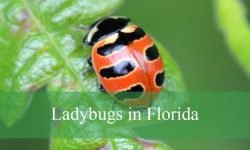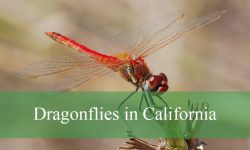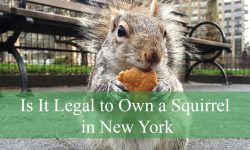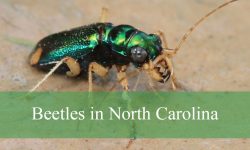Woodpeckers in Maryland are easy to spot thanks to their bold markings, drumming behavior, and energetic presence in forests and backyards alike. These birds are not only visually striking but also serve vital roles in the ecosystem, helping control insect populations and creating nesting spaces for other wildlife.
Maryland offers a rich variety of habitats that support different species of woodpeckers, from dense mountain forests in the west to suburban parks and open woodlands in the east. Some species, like the Downy Woodpecker, are seen throughout the year, while others, such as the Yellow-bellied Sapsucker, appear only during colder months.
This article highlights seven of the most common woodpeckers in Maryland, with helpful identification tips and pictures. By learning their behaviors and markings, you can better enjoy birdwatching and connect with the natural beauty found throughout the state.
Types of Woodpeckers in Maryland
Downy Woodpecker (Dryobates pubescens)
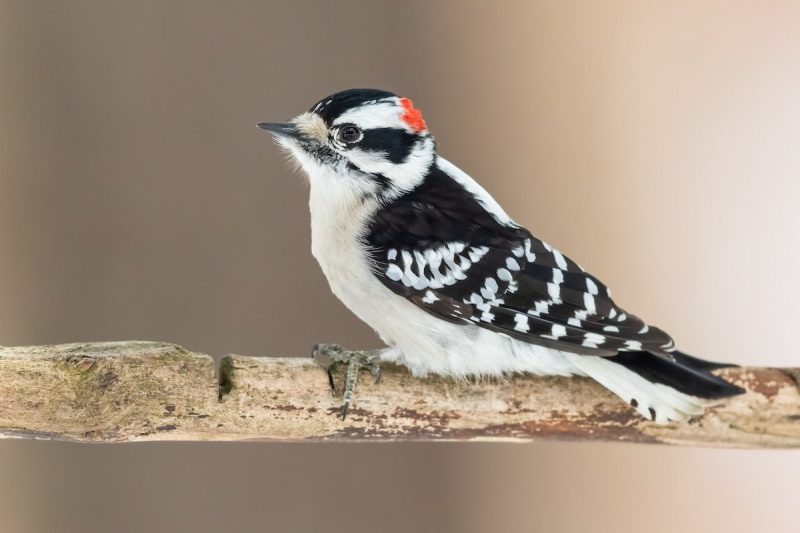
The Downy Woodpecker is the smallest woodpecker species found in Maryland, measuring about 5.5 to 6.7 inches in length with a wingspan of 9.8 to 11.8 inches. It is easily recognized by its white underparts, black wings speckled with white spots, and a clean white back. Males can be distinguished by the small red patch on the back of the head, a feature absent in females. The short, chisel-like bill is noticeably smaller than the Hairy Woodpecker’s.
This species exhibits acrobatic behavior as it forages, often hanging from slender branches and plant stems. It feeds primarily on insects like beetles, ants, and caterpillars, but also consumes seeds and berries, especially during winter. Downy Woodpeckers frequently visit suet feeders, making them familiar sights in suburban yards and parks.
Downy Woodpeckers thrive in a variety of habitats, including deciduous forests, mixed woodlands, orchards, and residential neighborhoods. They readily adapt to human presence, often nesting in dead tree limbs or birdhouses. Their nesting cavities are excavated in soft or decaying wood, usually 6 to 60 feet above ground.
In Maryland, this woodpecker is common and widespread across the state year-round. From the Appalachian forests in western Maryland to urban parks in Baltimore and suburban backyards in the east, the Downy Woodpecker is a dependable resident and a favorite among birdwatchers.
Hairy Woodpecker (Dryobates villosus)
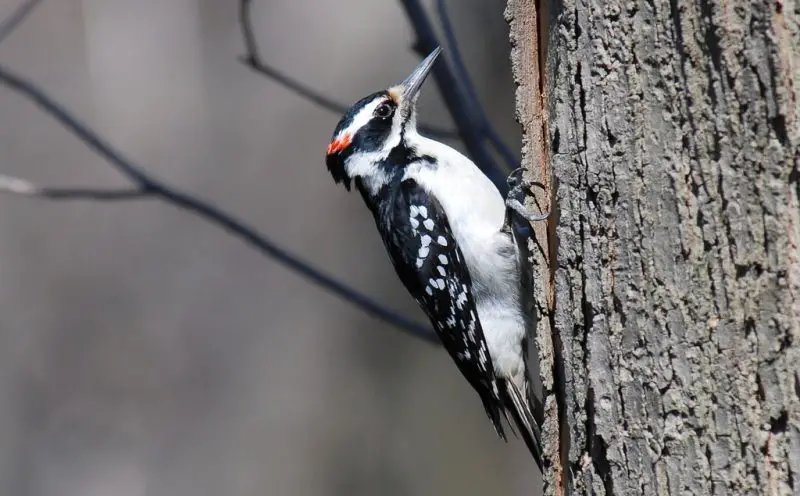
The Hairy Woodpecker closely resembles the Downy but is larger, measuring about 7.1 to 10.2 inches in length with a wingspan of 13 to 16.1 inches. It features a longer and sturdier bill, almost equal to the length of its head. Its plumage is similarly patterned with a white underside, black wings with white spots, and a white back. Males have a red patch on the back of the head, which females lack.
This woodpecker is more reclusive than its smaller cousin and prefers older, mature forests with large trees. It feeds on a wide range of wood-boring insects, larvae, and spiders, and will also consume nuts and berries when insects are scarce. It is a strong, deliberate driller, often heard tapping on tree trunks as it searches for hidden prey.
Hairy Woodpeckers nest in dead trees or limbs, excavating deep cavities that they reuse over several years. They tend to avoid urban environments but will visit feeders in rural or semi-rural areas, especially if suet is offered. Their behavior is more cautious, and they are less tolerant of human activity compared to Downy Woodpeckers.
In Maryland, the Hairy Woodpecker is found year-round, particularly in large tracts of forest, state parks, and wildlife reserves. Though not as abundant in cities or towns, they are still regularly seen in places like the Appalachian Mountains, Patuxent Research Refuge, and wooded areas near the Chesapeake Bay.
Red-bellied Woodpecker (Melanerpes carolinus)
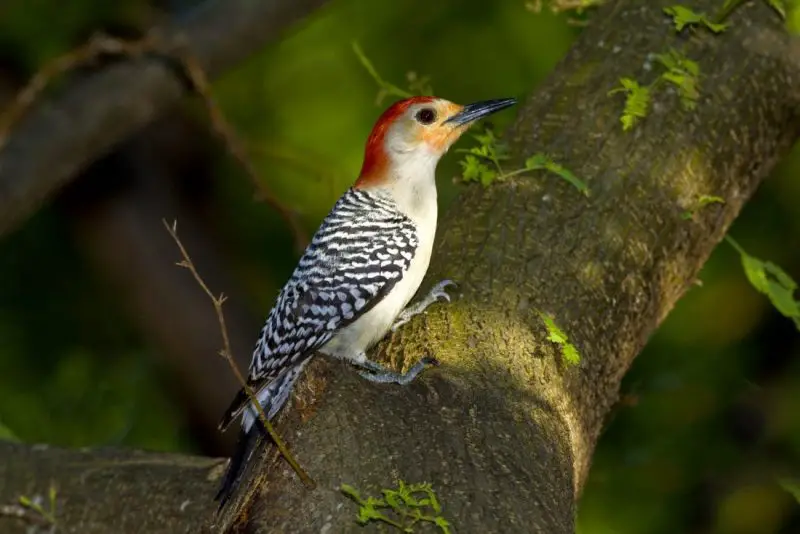
The Red-bellied Woodpecker is a striking bird despite the misleading name. The faint reddish wash on its lower belly is rarely visible, while its most noticeable features are the bright red crown and nape and its boldly barred black-and-white back. It is a medium-sized woodpecker, measuring about 9.4 inches in length with a wingspan of around 13 to 16.5 inches.
This species is highly vocal and active, often heard before it is seen. It has a varied diet that includes insects, fruits, nuts, and seeds. It frequently stores food in tree bark crevices and may even raid bird feeders, especially for peanuts and suet. Red-bellied Woodpeckers are known for their strong territorial calls and rolling “churr” sounds.
They prefer open woodlands, forest edges, and wooded suburbs. Red-bellied Woodpeckers nest in dead tree trunks and are often seen climbing up and down tree trunks with a distinctive bounding flight. Unlike some shyer woodpeckers, this species adapts well to human environments and is common in neighborhoods with mature trees.
In Maryland, the Red-bellied Woodpecker is one of the most frequently encountered woodpeckers. It inhabits forests, parks, and suburban areas across the state, from the Eastern Shore to the Appalachian foothills. Its bold appearance and vocal nature make it a favorite among backyard birdwatchers and nature enthusiasts.
Northern Flicker (Colaptes auratus)
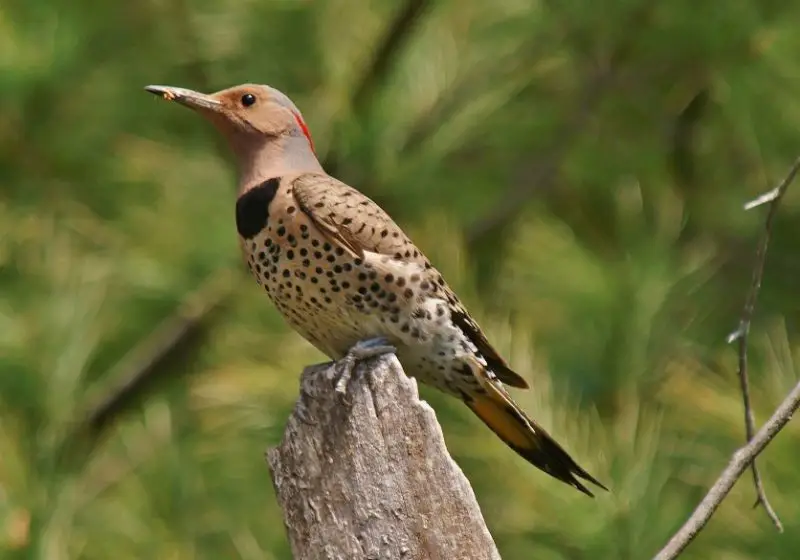
The Northern Flicker stands out among Maryland’s woodpeckers with its unique coloration and behavior. It has a warm brown body, covered with dark spots on the belly and flanks, a bold black bib on the chest, and a striking white rump patch that’s visible in flight. In Maryland, the “Yellow-shafted” form predominates, which features bright yellow underwings and tail feathers, as well as a red crescent on the nape in males.
Unlike most woodpeckers, the Northern Flicker often forages on the ground. Its diet primarily consists of ants, which it extracts using its long, barbed tongue. It also eats beetles, caterpillars, and occasionally fruits and seeds. When on the ground, it can be seen hopping across open areas or probing into anthills and lawns. Its call is a loud “wik-wik-wik,” often echoing through open woods.
Northern Flickers nest in cavities, usually in dead or decaying trees, and they readily use nest boxes when natural sites are scarce. They prefer open woodlands, forest edges, and suburban yards with scattered trees. They are also frequent visitors to birdbaths and suet feeders during colder months.
In Maryland, Northern Flickers are year-round residents and common throughout the state. They’re often spotted in parks, wooded neighborhoods, and near meadows or fields. Their unique ground-foraging habits and bold colors make them easy to recognize and enjoyable to observe.
Pileated Woodpecker (Dryocopus pileatus)
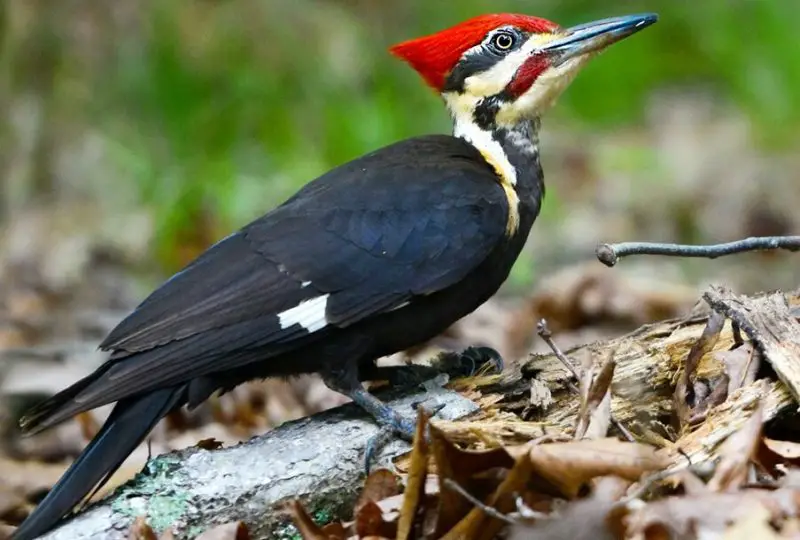
The Pileated Woodpecker is Maryland’s largest and most dramatic woodpecker, reaching up to 16 to 19 inches in length with a wingspan of nearly 30 inches. It is easily recognized by its flaming red crest, black body, and white stripes running down the neck. In flight, its white underwings and long wingspan give it a distinctive appearance. Both sexes look similar, though males have a red stripe on the cheek.
This powerful bird uses its large, chisel-like bill to excavate deep, rectangular holes in dead trees, which it searches for carpenter ants and wood-boring beetles. It also eats fruits and nuts, especially during fall and winter. The sound of its strong, echoing drumming and its wild, laughing “kuk-kuk-kuk” call are unmistakable in the forest.
Pileated Woodpeckers require large territories and favor mature forests with standing deadwood. They are less adaptable to urban settings and are rarely seen in residential areas unless near extensive woodland. Their nesting cavities are often reused by other species, such as owls, squirrels, and smaller birds.
In Maryland, they are found primarily in extensive woodlands, especially in western and central regions. Places like the Catoctin Mountains, Patapsco Valley State Park, and the forests of southern Maryland offer excellent chances to spot these impressive birds in their natural environment.
Red-headed Woodpecker (Melanerpes erythrocephalus)
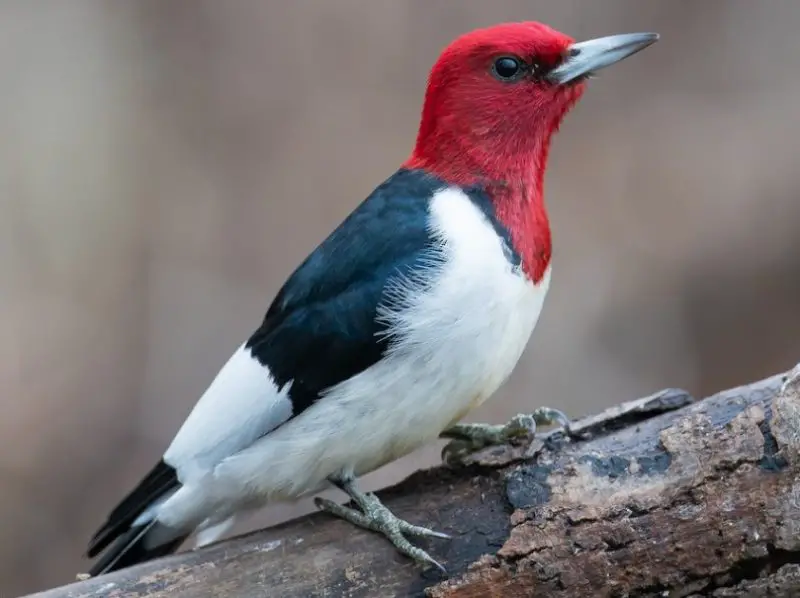
The Red-headed Woodpecker is one of the most visually striking birds in North America. Its entirely red head contrasts sharply with its bright white body and jet-black back and wings. The bold color blocks and glossy feathers make it easy to identify at a distance. Juveniles, however, are mostly gray-brown with a partially red head that becomes fully red with maturity.
This species is a versatile feeder, catching flying insects in mid-air, storing acorns in tree bark, and feeding on fruits and nuts. It’s also one of the few woodpeckers known to store food for later use. Red-headed Woodpeckers often perch conspicuously on dead trees or fence posts and may aggressively defend their territory against other birds.
Unlike most woodpeckers, it prefers open habitats such as savannas, agricultural edges, and stands of dead trees. It nests in tree cavities, especially in areas with little understory vegetation. These birds are sensitive to habitat changes and have declined in many parts of their range due to the loss of dead trees and open forest.
In Maryland, the Red-headed Woodpecker is locally distributed and less common. It is most often seen in the western and southern parts of the state, including places like Soldier’s Delight Natural Environmental Area and parts of Charles and Garrett Counties. Sightings may be seasonal, with some birds migrating short distances in winter.
Yellow-bellied Sapsucker (Sphyrapicus varius)
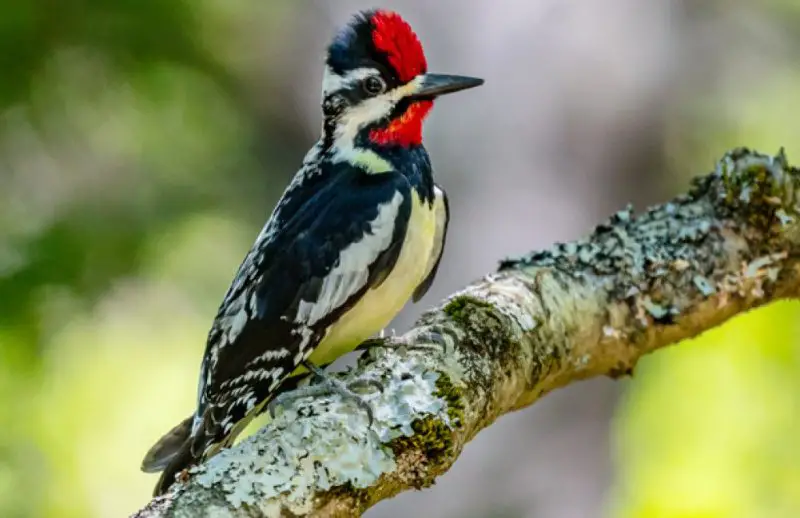
The Yellow-bellied Sapsucker is a migratory woodpecker seen in Maryland mainly during fall, winter, and early spring. It has a black-and-white barred back, pale underparts with a yellowish wash, and a bold white stripe on the wing. Males have a red throat and forehead, while females have only a red forehead and a white throat, making them relatively easy to distinguish.
This species drills neat, horizontal rows of small holes in the bark of trees, known as sap wells. It feeds on the sap that flows from these holes and also consumes insects attracted to the sap. It favors trees like birch, maple, and hickory. In winter, it may also eat fruits and berries, and occasionally visit suet feeders.
Yellow-bellied Sapsuckers are more secretive than other woodpeckers and are often heard before being seen. Their calls include soft “mew” notes and irregular drumming that starts rapidly and trails off. They nest farther north in the summer, particularly in Canada and the northeastern U.S., and return to Maryland only during the cooler months.
In Maryland, these sapsuckers are migratory visitors, particularly frequent in wooded areas during fall and winter. They can be seen throughout the state, especially in forested parks and natural areas with sap-rich trees. Though less conspicuous than resident woodpeckers, they play an important role in forest ecosystems by providing sap wells used by many other species.
FAQ About Woodpeckers in Maryland
What types of woodpeckers can be found in Maryland?
Maryland is home to seven main species of woodpeckers: Downy, Hairy, Red-bellied, Northern Flicker, Pileated, Red-headed, and Yellow-bellied Sapsucker. These birds can be seen across a range of habitats from dense forests to suburban backyards.
When is the best time to see woodpeckers in Maryland?
Most woodpeckers in Maryland are year-round residents, especially species like the Downy, Hairy, and Red-bellied Woodpeckers. Migratory species like the Yellow-bellied Sapsucker are most commonly observed during fall and winter.
What do woodpeckers in Maryland eat?
Woodpeckers feed on a mix of insects (such as ants, beetles, and larvae), tree sap, seeds, fruits, and nuts. Suet feeders are especially attractive to Downy, Hairy, and Red-bellied Woodpeckers in colder months.
Do woodpeckers cause damage to trees or houses?
While woodpeckers drill holes in trees to find food or create nesting sites, serious damage is rare in healthy trees. Occasionally, they may peck on wood siding or gutters for territorial drumming or nesting, especially during spring.
Where can I spot Pileated Woodpeckers in Maryland?
Pileated Woodpeckers prefer large tracts of mature forest and are most commonly seen in western and central Maryland, including areas like Patapsco Valley and Catoctin Mountain Park.
Are any Maryland woodpeckers endangered?
Most woodpeckers in Maryland are stable, though the Red-headed Woodpecker has experienced declines due to habitat loss. It’s considered less common and more localized within the state.
How can I attract woodpeckers to my backyard?
Providing suet, peanuts, and deadwood or snags can attract woodpeckers. Avoid pesticide use to ensure insect availability, and consider placing nest boxes for cavity-nesting species like the Downy and Hairy Woodpeckers.

